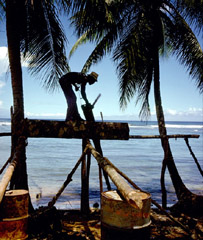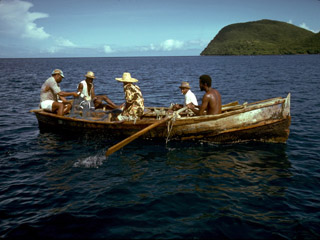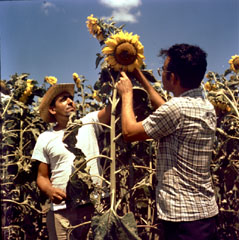 The small country of the Dominican Republic is about twice the size of the state of
New Hampshire in the United States. The central mountain range called the Cordillera
Central has the highest peak in the Caribbean at 10,000 ft. The Dominican Republic
shares the island of Hispaniola with the country of Haiti.
The small country of the Dominican Republic is about twice the size of the state of
New Hampshire in the United States. The central mountain range called the Cordillera
Central has the highest peak in the Caribbean at 10,000 ft. The Dominican Republic
shares the island of Hispaniola with the country of Haiti.
The nation has a variety of landscapes ranging from deserts in the south to alpine forests in the mountains. There are sugarcane plantations cover the coastal plains of the north and the east, and coconut plantations cover most of the tropical peninsula. White-sand beaches and warm water make the Dominican Republic popular among tourists.
The weather is mostly tropical. It is very warm and humid along the southern and
eastern coasts.
Government and Economy
The economy in the Dominican Republic is based largely upon agriculture. Pineapple,
coffee, sugar, cocoa, tobacco, and rice are the main crops. Tourism is another vital
source of income. The currency is the Dominican peso.
The country is divided into 29 provinces. The president, vice president, and the Congress (senators and deputies) are all directly elected by the people.
Language and People
 There are approximately 8 million people in the Dominican Republic. The largest
number of people lives in the capital city of Santo Domingo. There are also a great
deal of Dominicans that live in New York and are known as Dominican Yorks.
There are approximately 8 million people in the Dominican Republic. The largest
number of people lives in the capital city of Santo Domingo. There are also a great
deal of Dominicans that live in New York and are known as Dominican Yorks.
The official language is Spanish, but the Caribbena accents, phrases, and expressions
are common. One of the characteristics of Dominican Spanish is the tendency of
dropping the "s" at the end of the words. So words like nosotros become
nosotro'. Another common phrase is un chin. This phrase is used
instead of the common un poquito (a little bit), when talking about
quantities of things.
Greetings
The general greetings of ¡Buenos días!, ¡Buenas tardes!
and ¡Buenas noches! are commonly used. Remember that if you are meeting
someone for the first time to use the formal usted form of the Spanish verbs
to show respect. The titles of Señor (Mr.), Señora (Mrs.),
and Señorita (Miss) are also used.
The people in the cities of the Domincan Republic prefer to use the more familiar
tú instead of the more formal usted.
Food
Most meals in the Dominican Republic include rice and other favorites of
habichuelas (beans) and yuca (cassava). Plátanos
(plantains) and bananas are also abundant. Fruits are also plentiful. Dominicans
also eat small portions of chicken, meat, pork, and fish. The national dish is
sancocho, a rich vegetable and meat stew served mostly on special occasions.
Here is a recipe for:
Prepare fresh okra by trimming away the caps and tips, and cut into 1-inch sized pieces. Sprinkle chicken pieces with adobo, or salt and pepper. Heat oil in a wide cooking pot and brown chicken on all sides. Remove chicken to a plate and in the remaining oil, saute the onion, garlic, and bell pepper for 2 minutes.Chicken Stew with Okra & Plantains
Ingredients:
1 cup chopped okra, fresh or frozen 1 chicken, (21/2 to 3 lbs.), skinned and cut into 8 pieces 11/2 tablespoons adobo powder, OR
11/2 teaspoon salt and 1/2 teaspoon black pepper1/3 cup vegetable oil 1 large onion, chopped 3 cloves garlic, minced 1 medium green bell pepper, chopped 11/2 cups water 1-2 medium-ripe plantains, peeled and sliced into 2-inch rounds 2 medium tomatoes, coarsely chopped 2 tablespoons lime juice
Return the chicken pieces to the pot, and add the water, and plantain pieces. Cover and simmer for approximately 25 minutes, stirring occasionally. Add the okra, lime juice (keeps okra from getting slimy), and tomatoes.
Cover and continue to cook for another 10 to 15 minutes, or until chicken is tender
and easily falls away from the bone when pierced with a fork. Serve over white
rice, or eat as a stew.
Recreation
 The game of dominoes is a national pastime, cockfighting is also very popular.
The Dominicans also love music and dancing. Merengue
and salsa are all popular.
The game of dominoes is a national pastime, cockfighting is also very popular.
The Dominicans also love music and dancing. Merengue
and salsa are all popular.
Baseball is the most popular sport. Many Dominicans have become famous major league players in the United States.
Some important holidays include: Independence Day (February 27) and
Día de los reyes (Day of Kings, January 6). El día de los
reyes is when children are given presents instead of on Christmas.
For more information on the Dominican Republic, please visit the following site:
Photos courtesy of the UN.